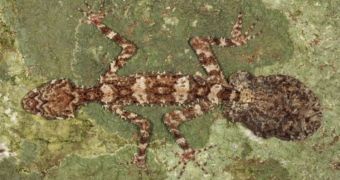A group of investigators with the James Cook University, in Australia, together with explorers from National Geographic, recently led an expedition to the Cape York Peninsula, located in the north-eastern part of the continent.
Their trip revealed three new vertebrate species that have remained hidden for millions of years, and have never before been observed by scientists.
The remote mountain range of the peninsula was only cursorily explored over the years, which is why JCU investigator Dr. Conrad Hoskin and Harvard University researcher Dr. Tim Laman decided to conduct an expedition here this March. Laman is also a photographer with National Geographic, which means that he was in charge of recording the expedition.
During the study, the team discovered a new species of leaf-tail gecko, a golden skink and a frog that lives on certain types of boulders. These creatures were found on the black granite boulders of Cape Melville, where such rocks pile hundreds of meters into the air.
This was one of the first times researchers investigated the rainforest atop Cape Melville's mountains. Filled with boulders, these forests and their clearings are naturally fortified by massive boulders, which make attempts at exploration very difficult.
In addition to the three newly-confirmed species, investigators also discovered several other creatures that may prove to be new to science as well. The team surveyed the concealed rainforest from a helicopter, but descended to snap photographs and film exotic wildlife whenever they saw something of interest.
Due to the inaccessibility of the studied area, animals trapped within this natural fortress have been out of contact with the rest of the world for millions of years. This implies that studying these species could lead to a series of significant insights into the evolutionary history of the world.
“Finding three new, obviously distinct vertebrates would be surprising enough in somewhere poorly explored like New Guinea, let alone in Australia, a country we think we've explored pretty well,” Hoskin says.
“These species are restricted to the upland rainforest and boulder-fields of Cape Melville. They’ve been isolated there for millennia, evolving into distinct species in their unique rocky environment,” the JCU expert goes on to say.
Hoskin has already named the three new species, details of which appeared in the October issue of the journal Zootaxa. The Cape Melville Leaf-tailed Gecko was named Saltuarius eximius, for its remarkable differences when compared to other types of geckos.
The Cape Melville Shade Skink was dubbed Saproscincus saltus, while the boulder-dwellign frog was named the Blotched Boulder-frog (Cophixalus petrophilus).
“The top of Cape Melville is a lost world. Finding these new species up there is the discovery of a life time - I'm still amazed and buzzing from it,” Hoskin concludes.

 14 DAY TRIAL //
14 DAY TRIAL //